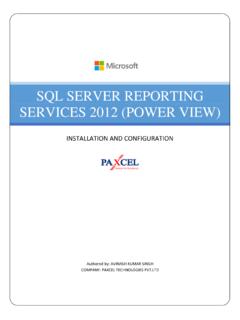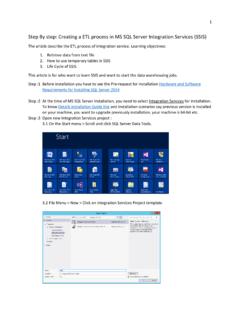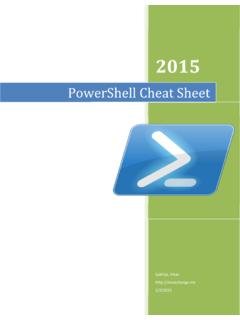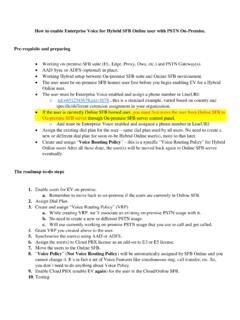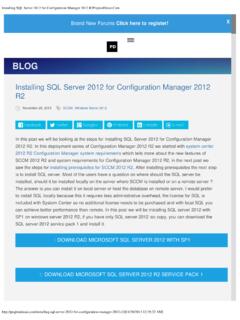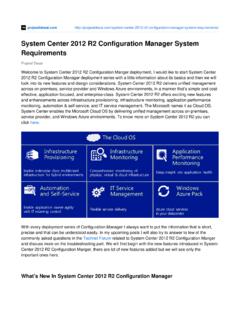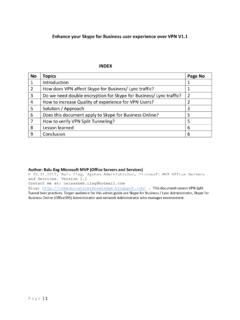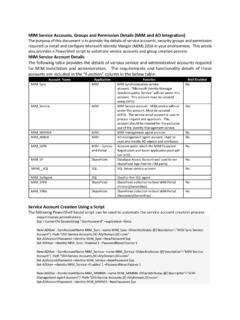Transcription of Step by Step Guide to Deploy Microsoft LAPS
1 step by step Guide to Deploy Microsoft LAPS In this document I will show you step by step method to Deploy Microsoft LAPS. The Local Administrator Password Solution (LAPS) provides management of local account passwords of domain joined computers. When LAPS is implemented, passwords are stored in Active Directory (AD) and protected by ACL, so only eligible users can read it or request its reset. For environments in which users are required to log on to computers without domain credentials, password management can become a complex issue. The Local Administrator Password Solution (LAPS) provides a solution to this issue of using a common local account with an identical password on every computer in a domain. LAPS resolves this issue by setting a different, random password for the common local administrator account on every computer in the domain. Domain administrators using the solution can determine which users, such as helpdesk administrators, are authorized to read passwords.
2 Imagine a scenario where you have got lot of servers and workstations. When it is not possible to use domain account to log on to server and perform administrative tasks, you are in a big trouble. Some scenarios that one could imagine without LAPS a) Machine loses connection to corporate network and there is not cached credential with administrative privileges. b) Machine loses connection with domain or is accidentally dis-joined from domain, so domain credentials cannot be used to log on to the server and repair it. For this type of support scenarios, support staff needs to know the password of local Administrator account to be able to log on to computer and perform necessary administrative tasks. What do I need before i Deploy Microsoft LAPS ?. To install Microsoft LAPS, you ll need at least one management computer, and at least one client computer. In my case I am installing the Microsoft LAPS on my domain controller.
3 There are some client machines that are part of domain, we will be deploying the LAPS software to these client machines as well. Supported Operating System Windows 10 , Windows 7, Windows 8, Windows , Windows Server 2003, Windows Server 2008, Windows Server 2008 R2, Windows Server 2012, Windows Server 2012 R2, Windows Vista Active Directory: (requires AD schema extension) Windows 2003 SP1 or later. Managed machines: Windows Server 2003 SP2 or later, or Windows Server 2003 x64 Edition SP2 or later. Note: Itanium-based machines are not supported. Management tools: .NET Framework & PowerShell or later How to install and Deploy Microsoft LAPS Software We ll now install the LAPS fat client, PowerShell module and Group Policy templates on the management computer. Click on the below button to download the Microsoft LAPS software. You can download both 64 bit and 32 bit versions. Download Microsoft Local Administrator Password Solution Software Once you download the LAPS software, copy the msi files to a shared folder on the server.
4 In my case I have created a shared folder on C drive and all the files downloaded are present there. Right click on LAPS x64 and click install. On the LAPS setup wizard, click Next. We will select all the features to be installed. Click Next. Click on Install. Click on Finish. The LAPS software has now been installed. Deploying LAPS to the client machines using GPO We will now configure a GPO to Deploy the LAPS software to the client computer. You could also use scripting method to Deploy LAPS. If you want to script this you can use this command line to do a silent install: msiexec /i <file location> /quiet or msiexec /i <file location> /quiet Just change the <file location> to a local or network path. Alternative method of installation to managed clients is to copy the to the target computer and use this command: Launch the Group Policy Management console, right click on the domain and click Create a GPO in this domain and link it here.
5 Provide a name to the GPO. Right click on the GPO and click Edit. In the GPM editor, expand Computer Configuration > Policies > Software Settings. Right click on Software Installation and click New > Package. Browse for the path where the files are located, select the LAPS software. Choose the deployment method as Assigned and click OK. You now see that LAPS x64 has been imported. In case you are adding x86 LAPS, once you add the package be sure to edit the x86 package to uncheck the option Make this 32-bit X86 application available to Win64 machines. You will find this option when you right click the x86 package > Properties > Deployment. This will ensure that 64-bit computers get the 64-bit DLL, and 32-bit machines get the 32-bit DLL. Close the GPM editor. To update the policy on the client machines, run the gpupdate command. On the client machine launch the control panel and click on Program and Features.
6 You will see that LAPS is installed on the client machine. How to configure Active directory for LAPS Let s see how to configure Active Directory for LAPS. We will first extend the AD Schema. Ensure that the user account that you use for this process should be a member of Schema Admins Active Directory group. The Active Directory Schema needs to be extended by two new attributes that store the password of the managed local Administrator account for each computer and the timestamp of password expiration. Both attributes are added to the may-contain attribute set of the computer class. ms-Mcs-AdmPwd Stores the password in clear text ms-Mcs-AdmPwdExpirationTime Stores the time to reset the password To update the Schema you first need to import the PowerShell module. Open up an Administrative PowerShell window and use the below command: Import-module Update-AdmPwdADSchema (This command updates the schema) Once you run the above commands, you will find the status of operation as Success.
7 Once you run the above commands, you will find the status of operation as Success. Note If you have an RODC installed in the environment and you need to replicate the value of the attribute ms-Mcs-AdmPwd to the RODC, you will need to change the 10th bit of the searchFlags attribute value for ms-Mcs-AdmPwd schema objet to 0 (substract 512 from the current value of the searchFlags attribute). For more information on Adding Attributes to or Removing attributes from the RODC Filtered Attribute Set, please refer to (v= ).aspx. In the next step we will grant computers the ability to update their password attribute using the Set-AdmPwdComputerSelfPermission command. In this example I have got the client computers in Comps OU . The Write permission on the ms-Mcs-AdmPwdExpirationTime and ms-Mcs-AdmPwd attributes of all computer accounts has to be added to the SELF built-in account. This is required so the machine can update the password and expiration timestamp of its own managed local Administrator password.
8 This is done using PowerShell. You may need to run Import-module if this is a new window. Set-AdmPwdComputerSelfPermission -OrgUnit <name of the OU to delegate permissions> Repeat this procedure for any additional OUs that contain computer accounts. Removing the extended rights To restrict the ability to view the password to specific users and groups you need to remove All extended rights from users and groups that are not allowed to read the value of attribute ms-Mcs-AdmPwd. This is required because the All Extended rights/permissions permission also gives permission to read confidential attributes. If you want to do this for all computers you will need to repeat the next steps on each OU that contains those computers. You do not need to do this on subcontainers of already processed OUs unless you have disabled permission inheritance. 1. Open ADSIEdit 2. Right Click on the OU that contains the computer accounts that you are installing this solution on and select Properties.
9 3. Click the Security tab. 4. Click Advanced. 5. Select the Group(s) or User(s) that you don t want to be able to read the password and then click Edit. 6. Uncheck All extended rights. To quickly find which security principals have extended rights to the OU you can use PowerShell cmdlet. You may need to run Import-module if this is a new window. Find-AdmPwdExtendedrights -identity OU NAME In the next step we will grant rights to users to allow them to retrieve a computer s password. We will use Set-AdmPwdReadPasswordPermission command to do this. Set-AdmPwdReadPasswordPermission -OrgUnit <name of the OU to delegate permissions> -AllowedPrincipals <users or groups> How to configure Group Policy for LAPS Launch the Group Policy Management console. I prefer to create a new policy to apply the password settings. Right click on the OU where your domain computers are present and click on Create a GPO in this domain and link it here.
10 Specify a name to this GPO and click OK. Next, edit the GPO. The settings are located under Computer Configuration > Administrative Templates > LAPS. You can see that there are 4 settings present. We will configure the ones that are required. Right click on the policy setting Enable local admin password management and click properties. As we want to manage the local administrator password, we will enable the policy setting. Click OK. The second policy setting that we will be enabling will be password settings. By default this solution uses a password with maximum password complexity, 14 characters and changes the password every 30 days. You can change the values to suit your needs by editing a Group Policy. You can change the individual password settings to fit your needs. Click OK. Administrator account name If you have decided to manage custom local Administrator account, you must specify its name in Group Policy.

